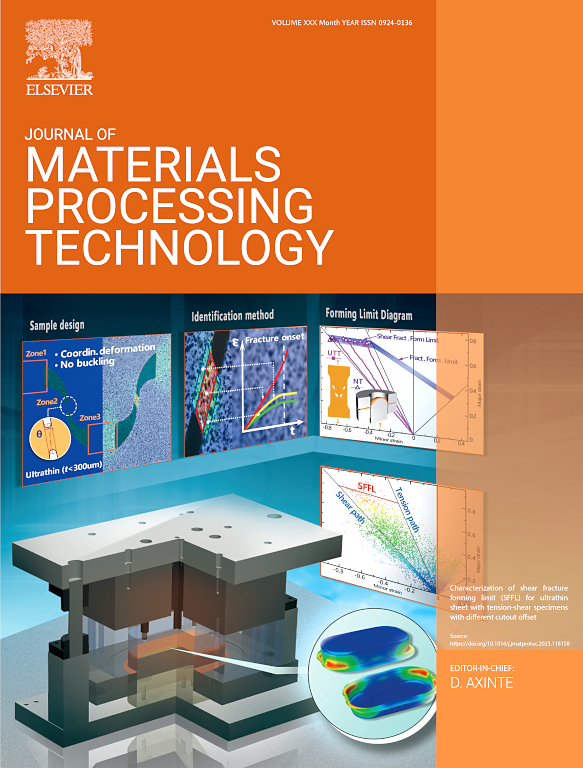非均质双线电弧定向能沉积马氏体不锈钢的热历史定制显微结构、显微硬度和拉伸性能
IF 6.7
2区 材料科学
Q1 ENGINEERING, INDUSTRIAL
Journal of Materials Processing Technology
Pub Date : 2025-05-15
DOI:10.1016/j.jmatprotec.2025.118904
引用次数: 0
摘要
马氏体不锈钢(MSS)以其卓越的性能而闻名。然而,目前的增材制造研究依赖于固定成分的预合金材料,限制了增材制造的灵活性。本研究利用非均质双线电弧定向能沉积(DED)技术原位制造MSS壁结构,采用55 % ER2209(双相不锈钢)和45 % ER70-G(低合金钢)的混合原料。采用了两种不同的层间冷却策略。在较短的层间冷却间隔下,明显的热积累使层间温度高于马氏体开始转变(Ms)温度,延迟相变直至沉积后冷却。这一过程产生了较粗的板条马氏体和残余的δ-铁素体,导致较高的强度和硬度,但较差的塑性。相反,延长冷却时间可以使层间温度接近室温,促进热循环诱导的显微组织-性能转变。这使最初的板条马氏体/δ铁素体转变为回火马氏体-奥氏体双相组织,促进了显微组织的细化。因此,尽管强度和硬度适度降低,但伸长率得到了改善。此外,本研究通过实验和模拟的协同结合,阐明了热历史与相变机制之间的内在相关性,再现了每次沉积过程中微观结构的演变。本文论证了采用普通异质焊丝制备MSS的可行性,阐明了原位制备MSS的热历史调控机理。本研究建立了一个可转移的理论框架,适用于不同材料系统的DED研究。本文章由计算机程序翻译,如有差异,请以英文原文为准。
Thermal history-tailored microstructure, microhardness, and tensile properties in heterogeneous double-wire arc directed energy deposited martensitic stainless steel
Martensitic stainless steel (MSS) is renowned for its exceptional performance. However, current researches on the additive manufacturing of MSS rely on pre-alloyed materials with fixed compositions, limiting the flexibility. This study utilized a heterogeneous double-wire arc directed energy deposition (DED) technique to in situ fabricate MSS wall structures, employing a hybrid feedstock of 55 % ER2209 (duplex stainless steel) and 45 % ER70-G (low-alloy steel). Two distinct inter-layer cooling strategies were implemented. Under shortened inter-layer cooling intervals, pronounced thermal accumulation elevated inter-layer temperatures above the martensite start transformation (Ms) temperature, delaying phase transformation until post-deposition cooling. This regime produced coarser lath martensite with retained δ-ferrite, resulting in higher strength and hardness but poorer plasticity. Conversely, prolonged cooling durations allowed inter-layer temperatures to approach room temperature, facilitating thermal cycling-induced microstructure-property transformation. This transitioned initial lath martensite/δ-ferrite to a tempered martensite-austenite dual-phase architecture and promoted microstructural refinement. Consequently, improvement in elongation was achieved despite moderate reductions in strength and hardness. Furthermore, this investigation elucidated the intrinsic correlation between thermal history and phase transformation mechanisms through a synergistic combination of experiment and simulation, reproducing the evolution of microstructure during each deposition. This work demonstrates the feasibility of fabricating MSS using common heterogeneous welding wires and clarifies the regulation mechanism of thermal history on the in situ fabricated MSS. This study establishes a transferable theoretical framework applicable to diverse material systems in DED research.
求助全文
通过发布文献求助,成功后即可免费获取论文全文。
去求助
来源期刊

Journal of Materials Processing Technology
工程技术-材料科学:综合
CiteScore
12.60
自引率
4.80%
发文量
403
审稿时长
29 days
期刊介绍:
The Journal of Materials Processing Technology covers the processing techniques used in manufacturing components from metals and other materials. The journal aims to publish full research papers of original, significant and rigorous work and so to contribute to increased production efficiency and improved component performance.
Areas of interest to the journal include:
• Casting, forming and machining
• Additive processing and joining technologies
• The evolution of material properties under the specific conditions met in manufacturing processes
• Surface engineering when it relates specifically to a manufacturing process
• Design and behavior of equipment and tools.
 求助内容:
求助内容: 应助结果提醒方式:
应助结果提醒方式:


